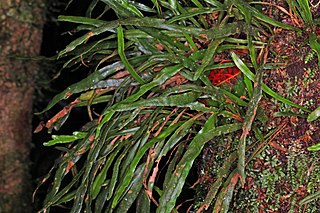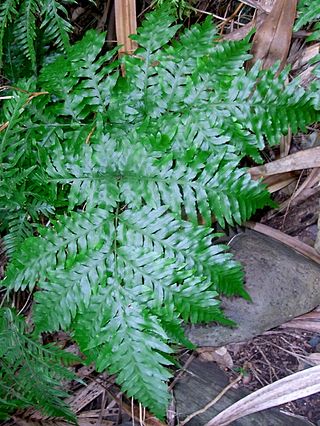
Melaleuca howeana, commonly known as tea tree, is a plant in the myrtle family, Myrtaceae and is endemic to the Lord Howe Island group, 600 km (400 mi) off the east coast of Australia. It is common in exposed areas, on cliffs and ridges, occasionally forming pure stands. Its closest mainland relative is Melaleuca ericifolia.

Ptisana howeana is a rare fern endemic to Lord Howe Island, occasionally found in cultivation. The local names are horse shoe fern or king fern. A large plant, though not particularly tall. The fronds grow to four metres long.

Parsonsia howeana is a vigorous twining vine of the family Apocynaceae. It is endemic to Australia’s subtropical Lord Howe Island in the Tasman Sea. It is common in the island's forests at low elevations.

Cranfillia fullagari, synonym Blechnum fullagarii, is a fern in the family Blechnaceae. The specific epithet honours James Fullagar, who collected plants on Lord Howe Island for the Royal Botanic Gardens, Melbourne.
Cranfillia geniculata, synonym Blechnum geniculatum, is a fern in the family Blechnaceae. The specific epithet refers to the geniculate base of the sterile fronds.

Parablechnum howeanum, synonym Blechnum howeanum, is a fern in the family Blechnaceae. The specific epithet refers to the locality to which it is endemic.

Alsophila ferdinandii, synonym Cyathea macarthurii, is a fern in the family Cyatheaceae.

Sphaeropteris robusta, synonym Cyathea robusta, is a fern in the family Cyatheaceae. The specific epithet alludes to its robust habit.

Lastreopsis nephrodioides is a fern in the family Dryopteridaceae. The specific epithet refers to its resemblance to Nephrodium decompositum R.Br..
Polystichum moorei is a fern in the family Dryopteridaceae. The specific epithet honours Charles Moore, Director of the Royal Botanic Gardens, Sydney, from 1848 to 1896, who collected plants on Lord Howe Island in 1869.

Polystichum whiteleggei is a fern in the family Dryopteridaceae. A former common name was heavy fern, alluding to the weight of one of the large, thick textured, fronds when fully developed. The specific epithet honours Thomas Whitelegge (1850–1927) of the Australian Museum, who collected zoological specimens on Lord Howe Island in 1887, who first noticed the fern's distinctiveness.

Grammitis diminuta is a fern in the family Polypodiaceae. The Latin specific epithet diminuta means "decreased" or "diminished", with reference to the tapered frond base.

Grammitis nudicarpa is a fern in the family Polypodiaceae.

Grammitis wattsii is a fern in the family Polypodiaceae. The specific epithet honours the Reverend W. W. Watts (1856–1920), a prominent Australian cryptogamist active in the late 19th and early 20th centuries.
Callistopteris bauerianum, known as the large filmy fern and Bauer's bristle fern, is a fern in the family Hymenophyllaceae. The specific epithet honours the Austrian botanical artist, Frederick Lucas Bauer (1760–1826), who collected plants on Norfolk Island in 1804–1805.

Hymenophyllum howense is a fern in the family Hymenophyllaceae. The specific epithet refers to the locality of occurrence.

Leptopteris moorei is a fern in the family Osmundaceae. The specific epithet honours Charles Moore, Director of the Royal Botanic Gardens in Sydney from 1849 to 1896, who collected plants on Lord Howe Island in 1869.

Pteris microptera is a fern in the family Pteridaceae.
Gahnia howeana is a flowering plant in the sedge family. The specific epithet refers to Lord Howe Island, where it is found. It was formerly lumped with Gahnia xanthocarpa, which is now considered to be endemic to New Zealand.
Planchonella reticulata is a flowering plant in the sapodilla family, Sapotaceae. It is a shrub or tree endemic to east-central New Caledonia. The specific epithet refers to the reticulate venation on the leaves.















